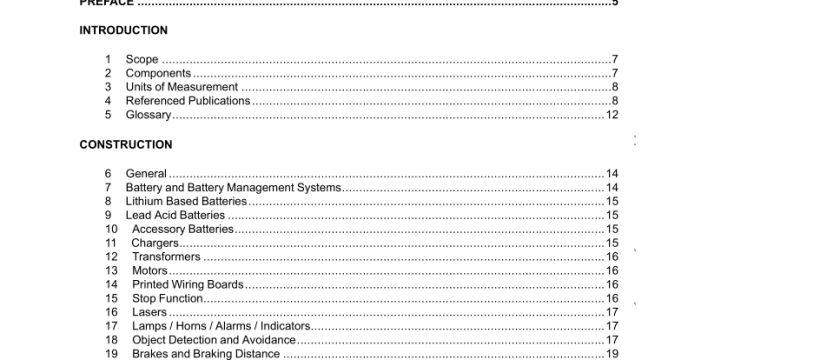UL 3100-2021 pdf download.Automated Mobile Platforms (AMPs).
1.1 These requirements cover battery-operated mobile platforms with or without a payload, as specified in 1.2. These devices are intended to be used indoors only or as outdoor use devices in a commercial or industrial environment. The device is battery powered using either lead acid batteries or lithium based batteries that, if rechargeable, are charged through a conductive system while either on board or off board the device. 1.2 Mobile platforms that are covered by this Standard are intended for lifting, carrying, product picking, towing, and the like. These actions may be provided by a gripping attachment, suction attachment, scope attachment, and the like, to lift or carry the load. 1.3 Portions of a system, such as the charger, that are located off board the AMP, are intended to be installed in accordance with the National Electrical Code (NEC), NFPA 70 and the Canadian Electrical Code (CE Code), CSA C22.1. 1.4 This Standard does not include requirements for industrial robots, which are covered under the Standard for Robots and Robotic Equipment, UL 1740 and Industrial Robots and Robot Systems, CSA Z434. A robotic manipulator that is in compliance with these standards may be used as the payload for the integrated system. 1.5 This Standard does not include requirements for Automatic Guided Vehicles or Automated Vehicles that function as commercial and industrial floor cleaning equipment. This equipment is covered under the standard for Particular Requirements for Rechargeable Battery-Operated Commercial Robotic Floor Treatment Machines with Traction Drives, CSA C22.2 No. 336. 1.6 This Standard does not cover battery powered industrial trucks that are rated Type E, EE, ES, or EX, and marked as such, as defined in the Fire Safety Standard for Powered Industrial Trucks Including Type Designations, Areas of Use, Conversions, Maintenance, and Operations, NFPA 505.
6 General 6.1 Unless otherwise stated, compliance with the requirements in this Standard is determined by evaluation and testing on a representative model of the device under evaluation. 6.2 AMPs covered by this Standard shall be provided with a means of conductive connection to the external charging device. While connected to the charger, the AMP shall not be capable of being energized in a manner that would allow movement of the AMP that would strain connections to the charger or cause the connection to break under load, unless evaluated for those conditions. Energizing systems for other than operation, such as communications, is allowed during charging. 6.3 No modification of the AMP shall be permitted to be performed by the user. The user shall not be instructed on how to modify the AMP. Instructions shall indicate that no modification is allowed, see 78.3. 6.4 All AMPs are considered suitable for use in an ordinary location. For any AMP that is intended to be operated in an area that is considered classified, further evaluation to determine suitability in that location is required. 6.5 AMPs are intended for indoor use only or as outdoor use devices. AMPs shall include the enclosure type rating on its nameplate label. See Environmental Considerations, Section 33. For indoor use only AMPs, the default ambient range is 0 °C to 40 °C (32 °F to 104 °F); and for indoor/outdoor use AMPs, the default ambient range is -30 °C to 40 °C (-22 °F to 104 °F). A manufacturer may choose an ambient range that extends outside this default range, such as a temperature lower than the lower limit or above the upper limit, but all AMPs shall meet the default range as a minimum.
8.2 A lithium based battery pack in accordance with 8.1 (c) shall comply with the requirements in the Overcharge Test, Section 58, with single fault conditions in the battery control circuits; Imbalanced Charging Test, Section 59; Vibration Test, Section 60; Shock Test, Section 61; and the Thermal Cycling Test, Section 62. 8.3 A lithium-based battery pack that relies on additional battery management external to the battery pack shall be subjected to the tests in 8.2 including single fault conditions in the battery control circuits external to the battery pack. 9 Lead Acid Batteries 9.1 Lead acid batteries shall be of the insulated type complying with UL 1989 and measures shall be taken to reduce the risk of connections becoming loose and causing arcing or overheating. 9.2 For lead acid batteries that are enclosed, means shall be provided to vent the off-gassing during charging. No arcing or sparking parts shall be present in the battery compartment. 10 Accessory Batteries 10.1 Batteries used to power accessories, and provided as an integral part of the accessory, shall be in accordance with the applicable standard for that accessory.UL 3100-2021 pdf download.
UL 3100-2021 pdf download
